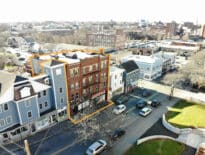
The common denominator in cities that saw rents fall in a pair of recent reports by Zillow and Redfin economists was a much-higher-than-average volume of new apartment construction. iStock photo
The laws of economics apparently work a bit differently in deep blue Massachusetts than in red states like Texas.
At least that is what an influential segment of progressive leaders in Greater Boston and other pockets of enlightenment across the state clearly seem to believe when it comes to the housing market.
Sure, uber-progressives like Boston Mayor Michelle Wu give lip service to the idea that building more housing is the key to bringing down rents and prices.
But it’s also pretty clear by their actions that Wu, or for that matter, a lot of local pols in Cambridge and Somerville, believe that the emphasis should really be on building subsidized units to be rented out or sold at below-market rates.
The idea of building more housing overall, especially if it involves so-called “luxury” units at the top of the rental or for-sale market, is viewed with suspicion.
In fact, there is a strong belief among some activists and progressive leaders that building more luxury units only helps push rents and prices higher and leads to gentrification.
A classic example of this view was the Globe’s “Towers of Wealth” piece last fall, which pushed a simplistic narrative of greedy developers only interested in building new luxury towers, middle-class housing be damned.
There was little or no examination in that piece of the NIMBY zoning rules and practices that drive up the cost of land and construction by dragging out the permitting process and severely and artificially restricting the units that can be built.
Rather, the Globe piece laid the blame on “development for the super-rich” that has “also diverted construction resources and bid up the cost of land, critics charge.”
All of which is a long-winded lead-up to some rather interesting new numbers released by economists at national online real estate giants Redfin and Zillow, reported online by this newspaper last week.
Rents Fell Where Permits Soared
After the initial shock of the pandemic wore off, apartment, condominium and house construction rose across the country.
And that has meant a big rise in the number of new apartments hitting the market in the last year or two, especially in red states where zoning laws and other restrictions on new construction are less onerous.
Overall, median rents have fallen in roughly half of the 33 major metro markets that Redfin tracks.
The common denominator, in turn, for cities that saw rents fall, rather than rise, was a much-higher-than-average volume of new apartment construction.
In the 16 cities where rents fell, local officials issued building permits for 14 new multifamily units per 10,000 residents, Redfin reports.
Jacksonville, Florida, for example, saw rents plunge 10 percent after issuing new permits for 23 new apartments per 10,000 residents.
Austin, a blue oasis in otherwise-red Texas, saw an explosion in new multifamily construction in the wake of the pandemic, with 40 new apartment and condo permits issued per 10,000 residents. Rents in Austin fell 7 percent.
SF Now Cheaper than Boston
As far cities where rents are rising, the number of new apartment and condo units permitted was half that, or seven per 10,000 residents.
That’s a group that includes the Boston area, which saw the number of building permits per 10,000 residents drop from nine during the 2021-2023 post pandemic surge to seven now.
Not coincidentally, Boston now has the third-most expensive rental market in the country, behind only New York and San Jose, Zillow reports.
The median rent in Boston is now $3,127, within spitting distance of New York ($3,472) and San Jose ($3,429), while a shade higher than San Francisco ($3,119).
Greater Boston also saw its median rent rise by 4.6 percent year-over-year, faster than the median national rent increase of 3.5 percent and far above most of the metro areas that issued double-digit numbers of permits for new multifamily units per 10,000 residents. Even in communities like those that saw rent increases, the upticks didn’t even crack the national rate of inflation.
When it comes to the housing market, bringing down rents and prices is a numbers game.

Scott Van Voorhis
And if the law of supply and demand works in the housing market in Florida and Texas, there is no reason it shouldn’t work here as well.
Scott Van Voorhis is Banker & Tradesman’s columnist and publisher of the Contrarian Boston newsletter; opinions expressed are his own. He may be reached at sbvanvoorhis@hotmail.com.





